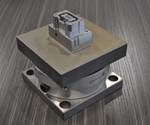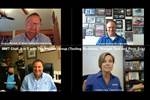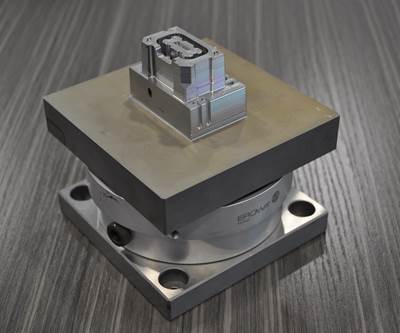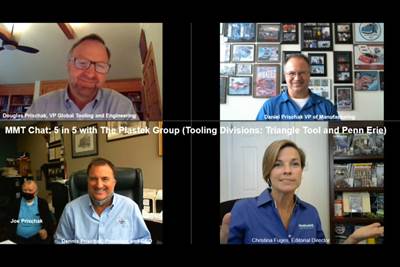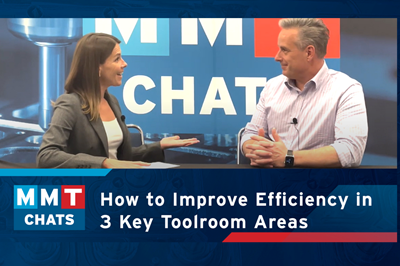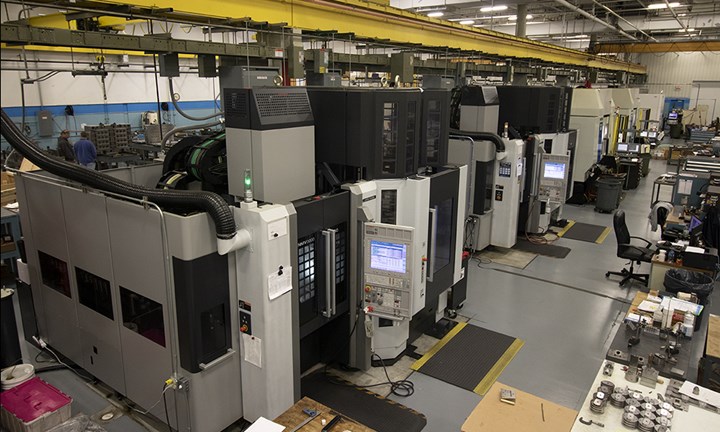
The Plastek Group is a 68-year-old moldmaker and custom injection molder with facilities in the U.S., Mexico, Brazil and the U.K. The company supports customers in the personal care/beauty, home care, pharmaceutical and food/beverage packaging segments. Above is the five-axis CNC row at one of Plastek’s Erie, Pennsylvania, moldmaking facilities. Photo Credit: The Plastek Group
The Plastek Group, which started life in 1956 as Triangle Tool Co., is a moldmaker and custom injection molder with facilities in Erie, Pennsylvania, Hamlet, North Carolina, Queretaro, Mexico, Indaiatuba, Brazil and Mansfield, U.K. The company produces tools in Erie and Indaiatuba, makes engineering changes in Erie, and molds in Hamlet and Mansfield. All facilities offer mold maintenance and repair. Core markets include personal care/beauty, home care, pharmaceutical and food/beverage packaging. Although most of the 20-30 injection molds the company builds annually are for its own molding operations, Plastek also produces tools for other molders.
Typical injection molds are high-cavitation tools for straight injection, two-shot, insert molding and stack molding with an occasional core-back mold to fit presses with clamp tonnage ranging from 85 to 1,200 U.S. tons/77 to 1,089 metric tons. Custom injection molding is supported by 450 molding machines at the various facilities. With significant expertise in the cap and lids segment, the company provides in-mold assembly of parts and supports customers via labeling, marking, printing, packaging and shipping.
Upgrading EDM capabilities
As part of an ambitious 5-year plan for equipment upgrades and replacements, in 2022, company management decided to swap out all EDM equipment at one of its two moldmaking facilities in Erie. Given the complexity of the molds Plastek makes, the company’s fleet of sinker and wire EDMs were careworn and ready for replacement with newer technology that was faster, more accurate and offered new capabilities. This would support the company’s goals to pick up more high-precision medical mold business.

Plastek produces 20-30 injection molds/year. These tools are typically high-cavitation for straight injection, two-shot, insert molding and stack molding to fit presses with clamp tonnage of 85 to 1,200 U.S. tons/77 to 1,089 metric tons. Given the complexity of the molds Plastek makes, the company’s fleet of sinker and wire EDMs were careworn and ready for replacement. Photo Credit: The Plastek Group
The assessment process began with the formation of two teams tasked with considering which wire and sinker EDM manufacturers to evaluate and then to develop a test piece that would mimic the most challenging geometries they cut or burned daily in order to put each type of EDM they were considering through its paces. Over many months, the teams also compiled a 32-point decision matrix against which each supplier would be evaluated, including test burn performance, volumetric accuracy, speed, surface finish, service and equipment availability, and long-term price stability since they planned to replace equipment at other facilities, too. With test pieces, a measurement system and target suppliers defined, a team of 15 Plastek members arrived at IMTS 2022 to meet companies, discuss equipment, try test cuts on the show floor and begin the process of whittling down the list of competitors.
After the show, more discussions ensued, both within Plastek and with target companies. Eventually, the list of companies was reduced to three: the company that had supplied Plastek’s older EDM equipment and two others that were well recommended. The teams visited two suppliers with North American tech centers as well as local moldmakers using EDMs from the three companies. They spent 6 months conducting their evaluations, including having their teams in Brazil also visit local tech centers and compare machines.
“We went into these evaluations figuring that newer EDMs would be faster and more accurate than the older equipment we’d been using, but we were shocked to find out just how much faster they were,” James Jergens, Plastek general manager, explains. “We were expecting new wire EDMs to be 20% faster, but found them to be 30-40% faster, and with sinkers, we found they ran 40-50% faster, which would significantly boost our productivity. We also knew we wanted to run more unattended hours nights and weekends, so we were interested in adding automation.”
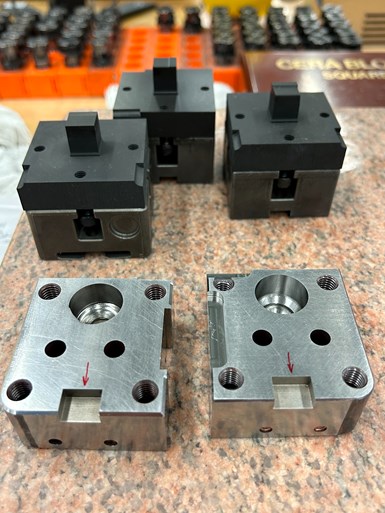
During Training Burn 1, the team compared the accuracy and speed of an identical test burn on a new Sodick sinker versus one of their legacy sinkers. The geometry was a 0.330 × 0.500-inch/8.38 × 12.7-millimeter rectangle that was 0.200 inch/5.08 millimeters deep in the Z-axis and featured a 0.005-inch/12.7-millimeter overburn on each side, plus a VDI 24 finish. Three electrodes were prepared for each test. Accuracy on both machines was comparable, but the burn on the Sodick was accomplished in 55 minutes, while it took 165 minutes to make the same burn on the older machine. There was also less wear per hit on each electrode used in the Sodick sinker. Photo Credit: The Plastek Group
The team awarded the entire contract to Sodick Inc. and submitted an order for two wire and two sinker EDMs, plus a small-hole EDM (also called a hole popper or EDM drill and used to produce small holes in hard materials) for one of their Erie facilities, with an additional wire and sinker for their Brazilian facility to follow. “We hadn’t owned Sodick equipment before, but we had friends and suppliers in the industry who’d had very good success with the equipment,” Jergens continues. “They told us that Sodick equipment runs and runs and just doesn’t break — but if it does break, then you can get service, which was really important to us.”
He adds that the team’s decision matrix proved very helpful in separating “I feel,” “I think” and “I want” elements from the discussions and helping them focus on service, speed and high tolerance. Ironically, he says that Plastek didn’t make its decisions based solely on price. “One competitor dropped its price to win the business, but we didn’t accept that because we wondered what would happen to us in the future when we put in additional orders,” Jergens adds. “Sodick gave us a fair price from the start; they answered our questions, listened to what we needed and worked closely with us to select the right equipment that met our requirements. We also felt that our two company cultures were well aligned. When we visited them, people really seemed to enjoy working with each other and for the company, which says a lot.”
Industry Innovator
Sodick Co. Ltd. was founded in Yokohama, Japan, in 1976 by an R&D engineer with significant experience designing EDM equipment. He went on to develop many of the industry’s most innovative technologies, including the first CNC-based sinker EDMs, the first linear-motor drive EDMs (replacing earlier ball-screw technology) and the first use of major ceramic components in EDMs. From Sodick’s inception, EDM has been its core technology and its mission has been to solve problems faced by the tool and die industry, which led to the development of injection molding machines and hybrid metal additive manufacturing printers. Today, the company says it’s the world’s largest EDM producer with the capacity to build more than 4,000 units/year. It also reports that it has built more than 80,000 EDMs of all types — 60,000 with linear motor drives — since its founding.
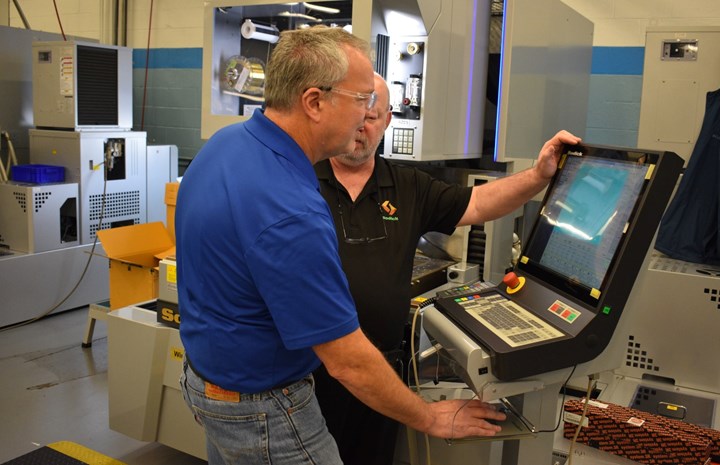
Plastek recently replaced its legacy EDMs with new sinker and wire EDMs and an EDM drill from Sodick after a rigorous vetting process. The added speed and accuracy will help Plastek compete for additional precision medical mold business. Above, Jim Linke, Sodick application engineer (black shirt), instructs Marty (blue shirt) from The Plastek Group on how to program one of the new Sodick ALN600G wire EDMs during a training session last November. Photo Credit: Sodick Inc.
In addition to Japan, Sodick also maintains manufacturing or sales facilities in China, Thailand, India, South Korea, Brazil, Europe and North America. However, the company says it has some presence in every industrialized nation. Sodick Inc.’s Schaumburg, Illinois, headquarters is where the company offers North American sales, service, training and engineering and maintains a parts inventory. It also has technical centers in Brea, California, Rockaway, New Jersey and Windsor, Connecticut, plus an R&D facility in San Jose, California, where it develops software, motion-control systems and human-interface devices.
Sodick EDMs are known for their stability, precision, speed, reliability and low cost of ownership. Stability is largely a function of the weight of the machines and their materials of construction, which include high-strength steel frames with hand-scraped dimensions and significant use of structural ceramic components in work zones — including the entire table on sinker EDMs. Not only are ceramic components strong and lightweight, which reduces wear on moving parts, but they’re also thermally, chemically and electrically stable and won’t corrode, contributing to reliability. Precision is achieved via machine stability as well as linear motor drives, which also contribute to speed — especially rapid acceleration — low wear and high reliability.
The team’s decision matrix proved very helpful in separating “I feel,” “I think” and “Iwant” elements from the discussions and helping them focus on service, speed and high tolerance.
In combination with unique technologies that reduce the use of consumables, these factors help keep the cost of ownership down. In fact, Sodick is said to offer the industry’s only 10-year Positioning Accuracy guarantee with no limits on machine hours on its linear-motor-drive wire and sinker EDMs. Even if a machine is purchased on the secondary market, as long as Sodick engineers inspect the machine, then decommission and recommission it, the warranty transfers to the new owner.
“Sodick is able to offer the industry better, more affordable technology because we’re so vertically integrated — all the way back to the foundry,” Dave Thomas, Sodick Inc. executive VP, explains. “We’re able to control quality from the outset because we manufacture more than 90% of each machine’s components. We’re not just assembling parts we outsourced to the lowest-cost producer. We even make our transformers, chillers, sheet metal, structural ceramics and controller software. That helps us offer highly reliable machines that are also highly energy efficient and less costly to run.”
For its Erie facility, Plastek ordered two ALN600G wire EDMs, two AL60G sinker EDMs and a K3HS EDM drill. “All five were stock machines without customization other than standard options, like macro-chucks and a 32-position toolchanger on the Z-axis of the sinkers, which also feature the latest-generation fuse-discharge control technology and wire automation interfaces,” Jim Knox, Sodick Inc. territory manager, recalls. “The size of the sinkers enables multiple workpieces to be ganged up together, permitting more unmanned burning, which was important to the Plastek team. Also, all machines feature Sodick’s advanced motion control technology, incorporating our rigid linear motor drives and motion controller and the latest machine learning algorithms in the control systems.”
Significant Time Savings
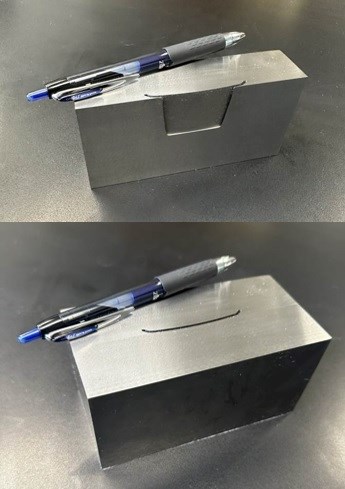
During Training Burn 2, the team needed to make a burn on a core block for a high-cavitation mold, producing flip-top lids for shampoo and body wash. The team decided to see if the deep but narrow rib burn could be made to save both time and cost and eliminate a potential flash point on molded parts. The test burn was made, including matching the texture specification. On the Sodick sinker, it took 95 minutes and two electrodes to make the burn. On the legacy sinker, the test was stopped after 390 minutes because it was deemed unable to complete the burn. Photo Credit: The Plastek Group
Since the machines were commissioned last November, Plastek has collected data on how long each burn takes and has found significant time savings. “With our new wire EDMs, we’re achieving a 20-25% reduction in burn time and we’re also benefiting from reductions in setup times, wire threading and pickup time compared with our previous equipment,” Jergens notes, adding that wire threading is more robust and they see fewer misfeeds. “Palletizing our sinkers and adding an Erowa Robot Multi automation box with a bigger payload also helped increase our productivity. The fact that Sodick came in 40% higher than the other competitors in our decision matrix gave us the confidence to pursue more tight-tolerance work, knowing that if anything does happen, we can quickly get the service we need to get back up and running again. We feel really comfortable knowing they still service every machine they’ve ever built.”
“Unlike our competitors, where EDM is a small part of everything they do, we live and breathe EDM and consider ourselves an EDM company that offers other products,” Thomas adds. “Our machines’ speed, accuracy and longevity sing very loudly.”
Related Content
Revisiting Some Hot Runner Fundamentals
What exactly does a hot runner do? If you’ve been in the injection molding industry for any length of time, you might think the answer is obvious, but it is not.
Read MoreHow to Eliminate Chatter
Here are techniques commonly used to combat chatter and guidelines to establish a foundation for optimizing the moldmaking process.
Read MoreIt Starts With the Part: A Plastic Part Checklist Ensures Good Mold Design
All successful mold build projects start with examining the part to be molded to ensure it is moldable and will meet the customers' production objectives.
Read MoreThe Benefits of Hand Scraping
Accuracy and flatness are two benefits of hand scraping that help improve machine loop stiffness, workpiece surface finish and component geometry.
Read MoreRead Next
The Impact of 3D Printing on Wire EDM
3D printing impacts wire EDM workholding, cutting conditions and machine tool specifications.
Read MoreMMT Chats: 5 in 5 with The Plastek Group (Tooling Divisions: Triangle Tool and Penn Erie)
MoldMaking Technology Editorial Director Christina Fuges has a quick 5-minute chat with Douglas Prischak, VP Global Tooling and Engineering for The Plastek Group in Erie, Pennsylvania, on five best practices for improving efficiencies. This episode is brought to you by ISCAR with New Ideas for Machining Intelligently.
Read MoreMMT Chats: How to Improve Efficiency in 3 Key Toolroom Areas
MoldMaking Technology Editorial Director Christina Fuges chats with James Jergens, General Manager for Triangle Tool and Penn Erie Tool of The Plastek Group about three simple ways to improve efficiency: tool design, equipment and work in process. This episode is brought to you by ISCAR with New Ideas for Machining Intelligently.
Read More

.jpg;width=70;height=70;mode=crop)
